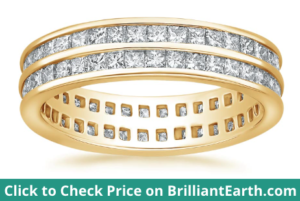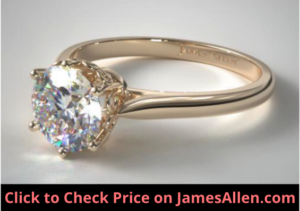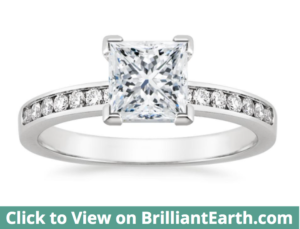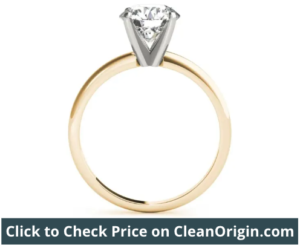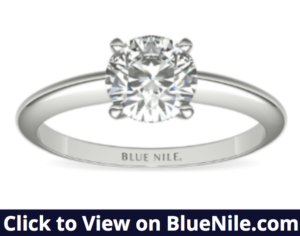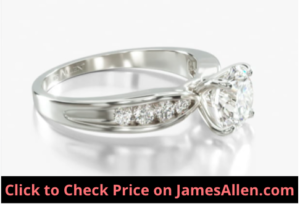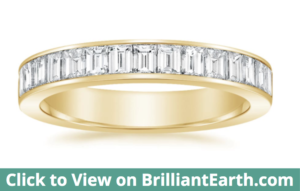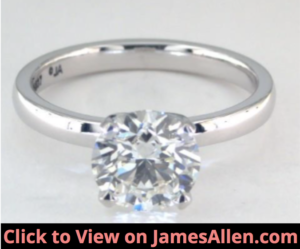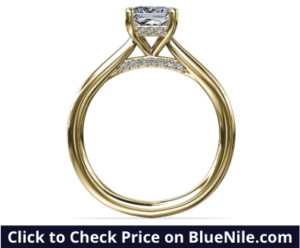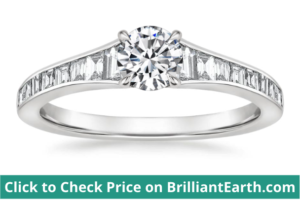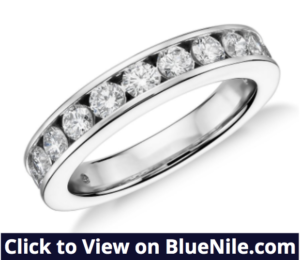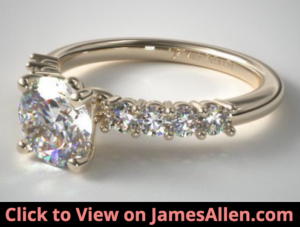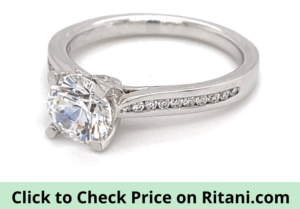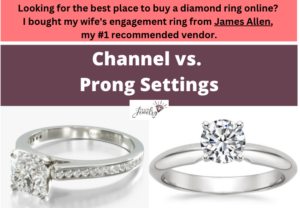
A diamond is the most important part of a ring, but the setting is a close second.
Two of the most popular are channel settings and prong settings.
The main difference between channel and prong settings is the channel refers to a crevice inside the ring that holds small diamonds. Prongs are thin claws that grip a diamonds crown to hold it in place. Channel settings can use prongs to hold the center diamond.
Let’s compare channel versus prong settings, including an overview of each and 10 differences that will help you make the right decision.
What is a Channel Setting?
A channel setting features small diamonds or other gemstones set inside a groove within the shank. The crevice includes a lip that stretches over the edges of the stones to hold them in place.
It’s a way to place the diamonds into the band for increased security.
Check out the channel setting below and the way it holds 26 round-cuts.
You can rotate the image on the vendor’s to learn how it looks at each angle.
Channel set designs can hold many shapes. The most popular is round, but you can also choose princess, oval, emerald, or cushion cut diamonds.
In addition to a variety of shapes, the diamonds can be placed all the way around the ring or just on the half leading up to a center stone.
As an example of the former, here’s a channel-set ring with 74 diamonds circling the whole piece.
The total carat weight (CTTW) across two layers of this eternity setting is 1.67.
What is a Prong Setting?
A prong setting is the traditional style for an engagement ring, where the center diamond is held by three, four, or six metal prongs extending from the shank. It’s also called a claw setting, but as we’ll discuss later, “claw” is referring to a specific style.
The ring below includes six prongs.
Rotate the image and check out their position around the diamond.
Notice how prongs grip edges of the stone and maximize the amount of exposed diamond compared to other settings.
They hold nearly every diamond shape because the tips of the prong can be configured to allows it to grip unusual shapes like heart, marquise, and trillion cuts.
How are Channel and Prong Settings Different?
1. Security
Protecting diamonds is often a priority for buyers because of their significant cost. Channel settings are prized for the way they secure the diamonds into the band.
The image below is of the top-down view of a channel setting.
It’s easy to see how the diamonds are set into the groove. They aren’t as exposed to hits or bumps. Instead, they’re protected by the metal that surrounds them.
If you run your finger along the band, it may not even come into contact with the diamonds because of the metal extending over them holds each in place.
Prong settings leave the diamond exposed. Its only protection is thin prongs grasping the edges. If it’s dropped or hit, there isn’t anything to protect the diamond’s table from contact.
Avoid wearing a ring with a prong setting during physical activity.
Although prongs are typically found on top of the ring holding the main diamond, there are instances where tiny prongs are placed along the ring to hold accents.
The above notes on security apply there too. They’re more exposed compared to channel.
Even though you should still take steps to avoid damage to your channel setting, its design is more fit for the minor drops and bumps it may experience when you wear it.
2. Cleaning and Maintenance
I recommend having your diamond ring cleaned once or twice a year. It’s easier with prong settings versus channel settings.
There are fewer nooks for dirt and debris in prong settings.
In the setting below, take note of its simplistic design.
There appears to be few places that could accumulate debris. If it does, they’re easy to reach and wouldn’t always require a professional to delicately do so.
The best solution is warm water with dish soap. Soak your ring for 20 to 40 minutes and then gently brush it with a soft toothbrush.
Channel settings are difficult to clean because grime lodges in the channel and between the small diamonds. It may take more than soaking it to remove these issues.
Ultrasonic cleaners have the potential to shake stones loose.
Consult with a professional, who can remove debris from those small areas without disturbing any diamonds.
3. Prongs Snag
One downside of prong settings is they snag on hair and clothing.
Whether the prongs have rounded or sharp ends, it’s easy for them to get caught, which may bend them backwards.
When they’re no longer pressed tightly against the diamond, it may fall out.
This prong setting has pointed ends.
You can imagine how if they’re aren’t secured close enough to the diamond, it would be easy for them to catch.
To avoid this challenge, keep them in top shape. If they experience wear and tear and start to bend backward, don’t wear it until you have them repaired.
This isn’t a problem with channel settings. The smooth edges of the crevice, like the one seen in this channel set engagement ring, won’t snag.
But as you can see, the main diamond is held with prongs, so you could experience the same problem there.
4. Resizing
If you’re buying a channel setting, you should find the right size the first time because they’re difficult to resize.
To resize a ring to a smaller size, the jeweler removes a piece of the shank and forms it back together. Resizing a ring to a larger size is more difficult.
To increase it a half size, the jeweler can stretch the metal. For more than that, they must cut the metal, add an extra piece, and then solder it back together.
This isn’t easy to do when the band is filled with small diamonds. Imagine trying to deconstruct this channel-set wedding ring to resize it and then fitting the diamonds back into place.
The channel must be the exact width to fit the diamonds and hold them in place.
Any adjustments to the size of the ring must take into account the channel’s width and the placement of the diamonds.
Prong settings, on the other hand, don’t require removing and replacing diamonds within the band.
The diamond can be removed from the prongs while the band is resized. It’s still an inconvenience and requires the work of a professional, but the effort isn’t comparable to resizing a channel setting.
The exception is if its a prong setting that still features other diamonds. For example, if might have a halo and pave.
Resizing this would require many of the same difficulties as a channel setting.
5. Prongs Better Display Diamonds
The disadvantages of a prong setting are outweighed by the way a prong displays the center diamond.
They’re designed to maximize brilliance because it leaves as much of the diamond exposed as possible.
To illustrate, here’s an engagement ring with a four-prong setting.
Light can enter the table and on all sides because the prongs only block a small part of its edges.
Additionally, many prongs are high-set, meaning the diamond is placed high above the band. Here’s an example of a high cathedral setting.
This allows it to capture and reflect the maximum amount of light instead of hiding its sides and pavilion with the shank.
Channel settings aren’t designed to fully display the diamonds. The table is exposed, but its sides and pavilion are hidden by the channel or the other diamonds.
The focus is still on the brilliance of the center diamond, but the channel-set gems enhance rather than distract from the main one.
It’s important to find ones of high enough quality that they don’t cause the piece to appear dull, but colorless diamonds with an excellent cut are often reserved as the center diamond.
6. Sparkle
An advantage of the channel versus prong setting is the additional diamonds add more sparkle to the ring. Solitaire prong settings rely on intense sparkle from a single diamond, but channel settings allow you to create a glimmering piece of jewelry without a large stone.
If you’re budget prevents you from buying a heavy center diamond or one with an excellent cut, channel-set diamonds are an exceptional way to compensate.
Some channel settings only include a few diamonds on each side of the main one, but you can add more glimmer with a design that includes accents all the way around.
Because these channel-set diamonds are smaller, you can find ones with quality cuts and a colorless aesthetic for a lower price.
The sparkle can also appear more as a warm glow than white light by using step-cuts. As an example, here’s a channel setting with baguette cuts inside the grooves.
Those accents won’t radiate the same way as round cuts but still shine when the ring is twirled.
7. Popularity
Prong settings are the most popular type of setting. It’s the most commonly used design for displaying the center diamond on an engagement ring.
It offers the ideal balance between security, affordability, and brilliance. A solitaire setting with prong avoids stealing attention from the main diamond, which is the often the most expensive element to the ring.
If you’re looking for the traditional style, choose a prong setting.
Channel settings are included in the list of settings that have seen rises and falls in popularity, such as tension and bezel settings.
It offers unique advantages such as the ability to have a sparkling ring all the way around, but its downsides have left many buyers opting for a prong setting.
8. Channel Settings are Used for Wedding Rings
Channel settings allow for an upgraded wedding ring. While some wedding rings are a solid band without any diamonds, the channel setting is the perfect option for someone wanting additional shine.
Check out the channel-set wedding ring below.
The round cut diamonds offer a degree of brilliance not found in the classic style.
The channel can be added to the whole ring or just one half. It can feature anywhere from 10-30 round shaped diamonds in a variety of metals such as 18K yellow gold or 14K white gold.
Prong settings are more often seen in engagement rings. Engagement rings are all about the center diamond. It’s natural to choose a setting where it’s the main focus.
Pair a channel and prong setting ring next to each other as a wedding ring and engagement ring.
This creates a stackable style where the channel fits under the prong setting. The prong setting highlights the engagement ring diamond, while the wedding ring sparkles along the entire band.
9. Prongs Wear Thin and Break
Thin prongs allow you to showcase a larger surface area of the diamond, but they can experience wear and tear that eventually causes them to break.
Notice the thin prongs on this diamond ring.
They’re even difficult to identify when the metal matches the rest of the shank.
Whether the prongs are slowly worn down over many years, or are struck against a hard surface, they aren’t the most durable type of setting.
One way to reduce this risk is to include a higher number of prongs. The classic Tiffany setting with six prongs provides more security than a three-prong setting.
There’s minimal risk for wear and tear on a channel setting. The thicker metal leaves it less vulnerable to reshaping in a way that would cause the diamonds to fall out.
The issue is while prongs are an easier fix, problems with channel settings are harder to repair because of the high number of small diamonds.
10. Design Variations
The primary variations for channel settings are the types of diamonds placed in the channel and how far they wrap around the band.
You can add princess cuts, round cuts, and more, and these designs can run along the top half of the band or around all of it in an eternity setting.
In the example below, round cut diamonds form a half-eternity style channel setting.
The band can also be in multiple types of metals such as platinum, rose gold, or yellow gold.
There are many variations of prong settings. The differences are the number and shapes of the prongs. For example, the prongs can have a V-shape at the end, with a cut down the middle. This design is ideal for holding the sharp corners of princess and emerald cuts.
The prongs can also be flat. Flat tab prongs have a flatter tip that presses tightly to the diamond. Its advantage is it doesn’t snag as easily.
Shared prong settings feature a row of multiple, larger diamonds that share a set of prongs with the one next to it. It minimizes the amount of visible metal so more light can hit the diamonds.
How to Decide Between Channel and Prong Settings
You’ll often see prong settings when there’s a center diamond as the main focus, but channel settings can be used with or without a main diamond.
If your priority is maximizing the appearance and brilliance of a quality stone, choose a prong setting. It lets in the most light and draws attention to the most important part of the ring.
If you’re opting for a smaller diamond and want the shank to sparkle, a channel setting is the right choice for you. Choose the number and cut of the small stones and have them placed securely in the band.
But your choice isn’t only one or the other. For a truly brilliant ring, combine a high-quality diamond held by prongs with a row of accents in a channel setting.
You’ll display brilliance on top and only add to it with the diamonds set in the channel.

Jacob Clarke
Jacob Clarke is the founder of TeachJewelry.com.
He earned an Applied Jewelry Professional Diploma from the Gemological Institute of America (GIA) and now brings you essential information about diamonds, settings, and more.
Jacob has consulted with leading jewelry brands, and his work has been cited in Clean Origin, Diamond Nexus and industry publications.
He's also a member of the International Gem Society.
He enjoys discussing jewelry with readers, so contact him with any questions at jacob.clarke@teachjewelry.com.


